新概念英语第一册Lesson129-130(共56张PPT)
文档属性
| 名称 | 新概念英语第一册Lesson129-130(共56张PPT) | 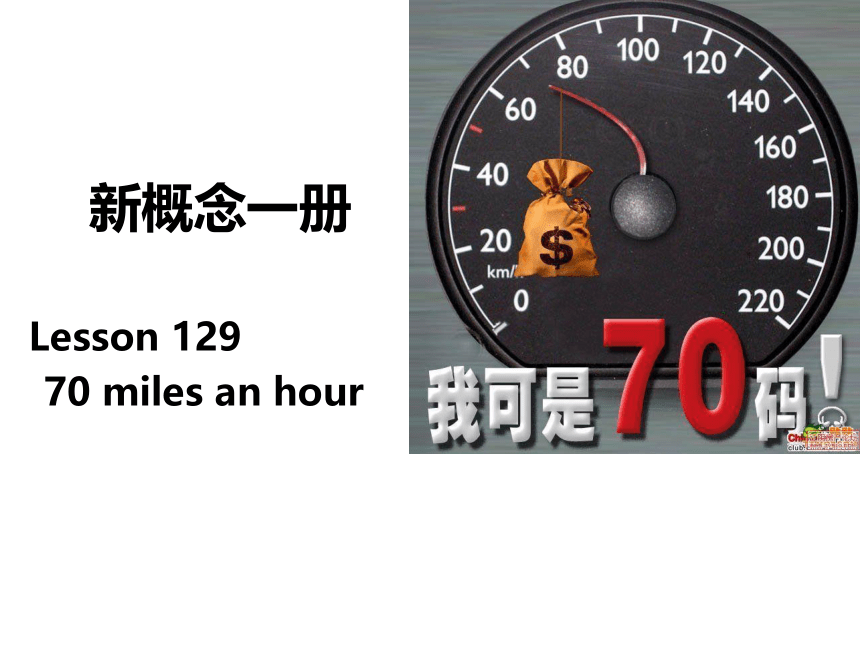 | |
| 格式 | ppt | ||
| 文件大小 | 9.2MB | ||
| 资源类型 | 教案 | ||
| 版本资源 | 新概念英语 | ||
| 科目 | 英语 | ||
| 更新时间 | 2024-04-09 09:56:07 | ||
图片预览

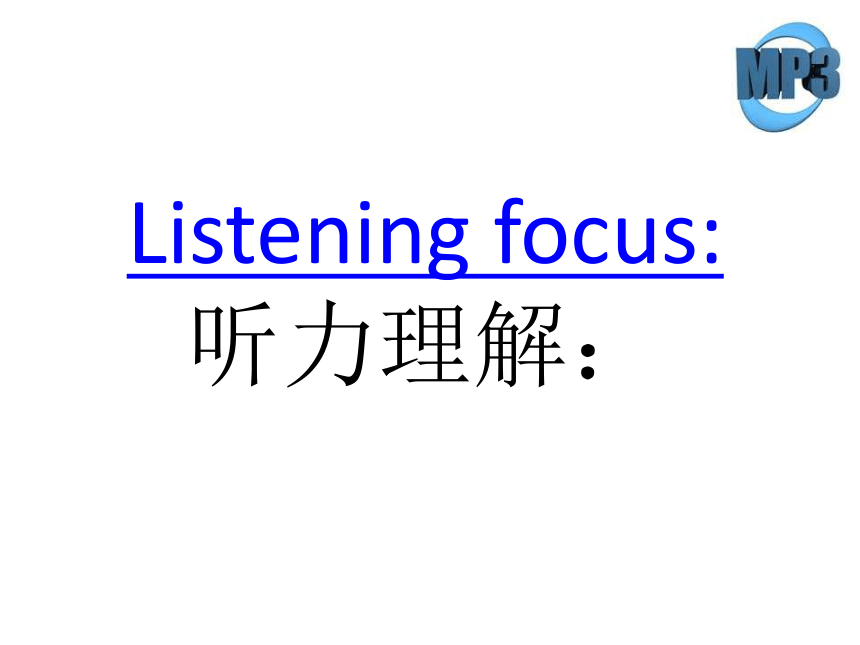


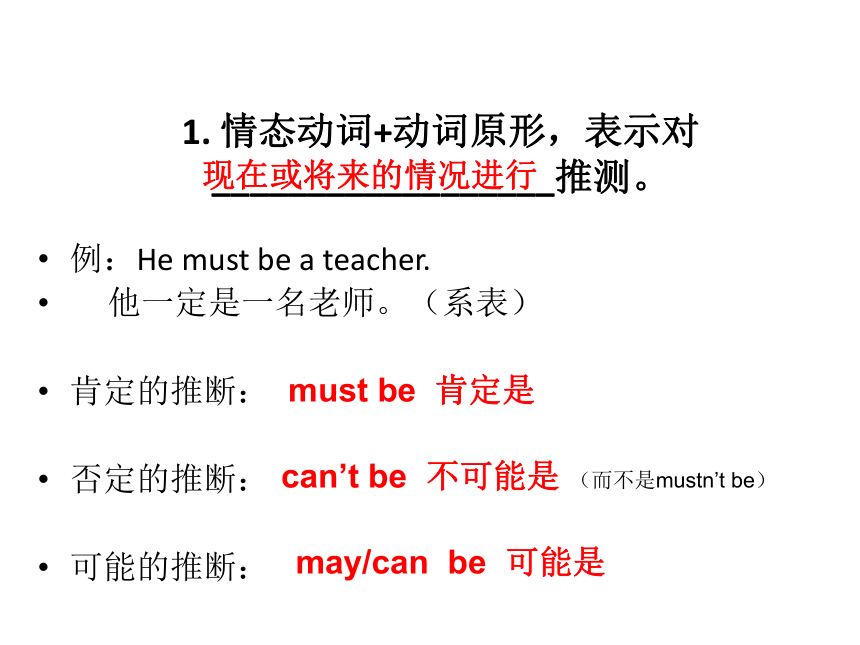
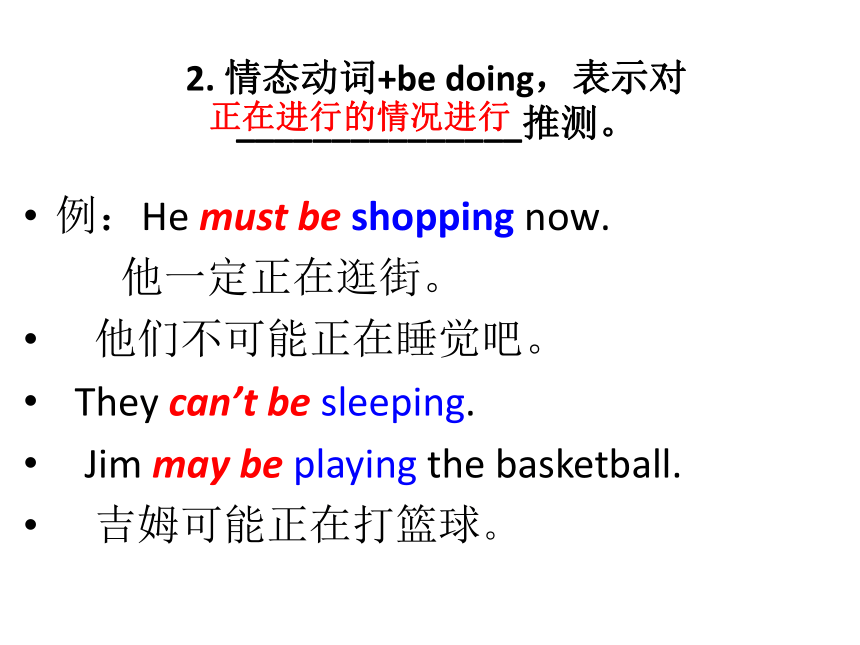
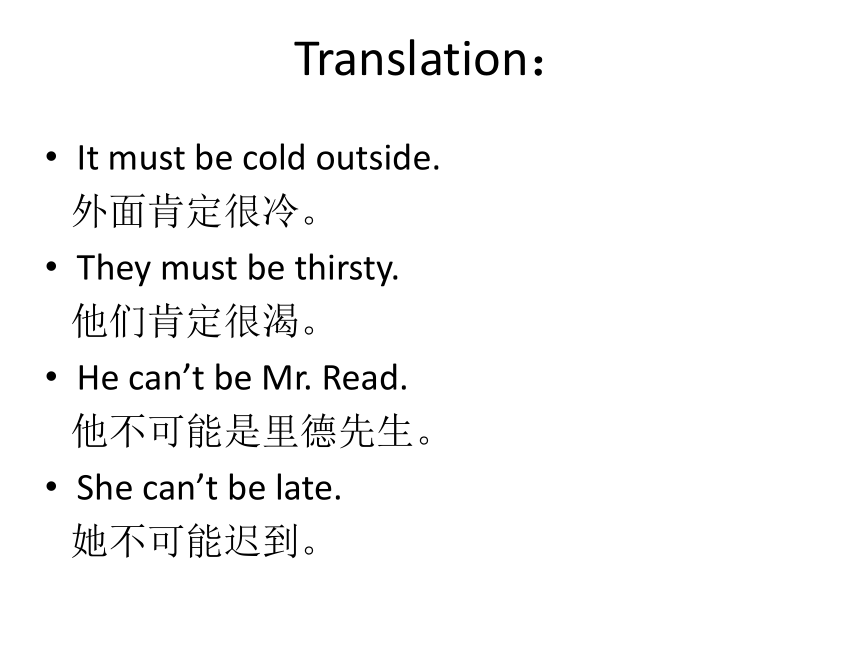
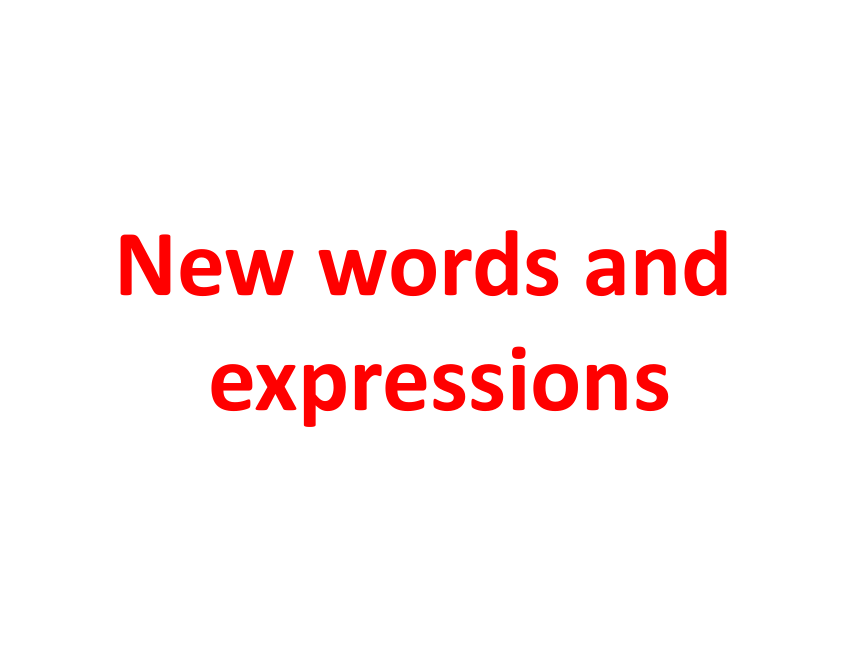
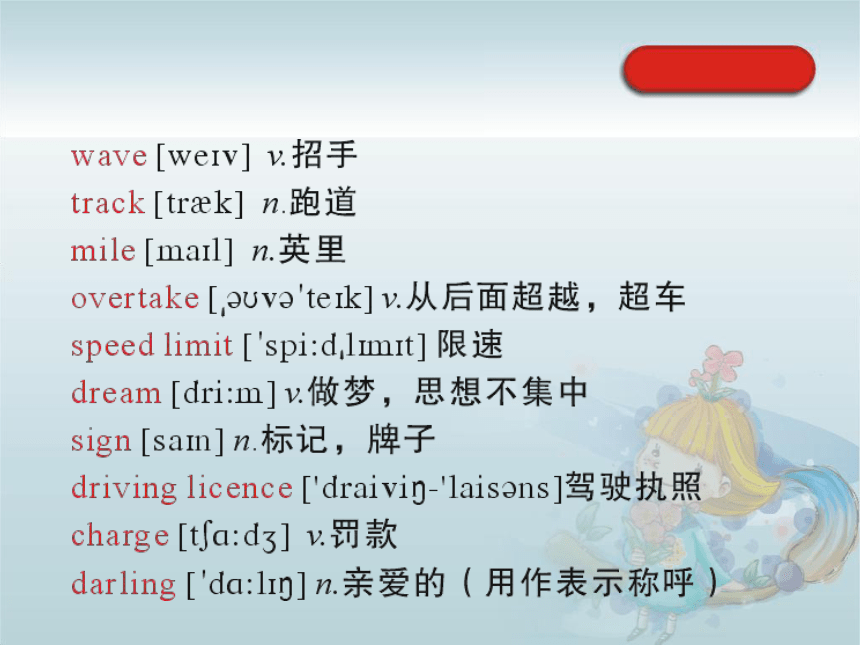
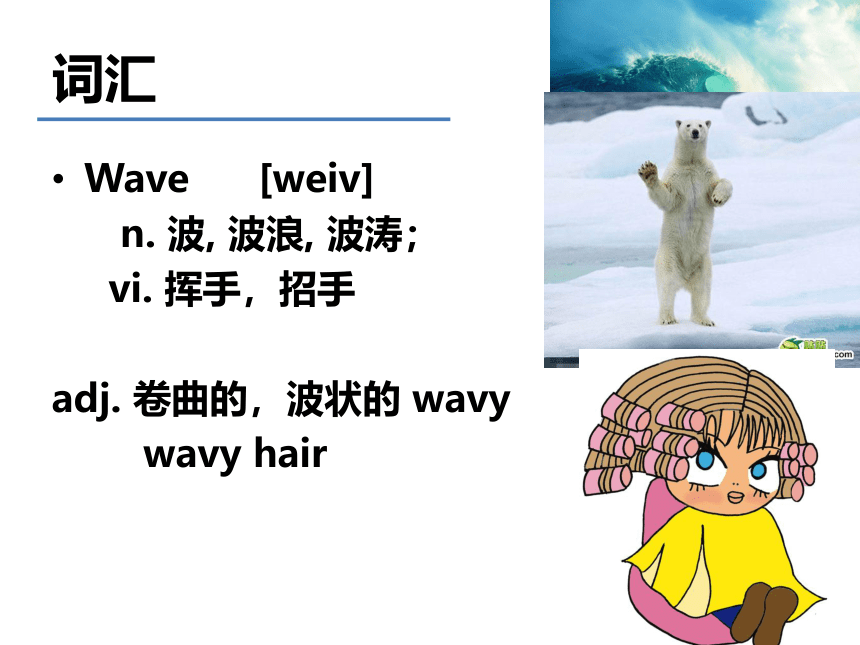
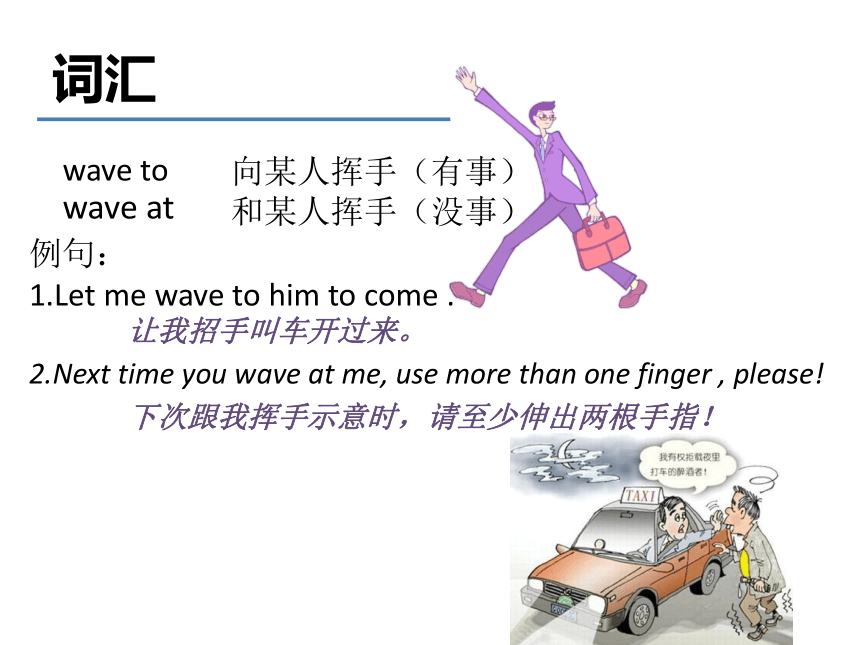
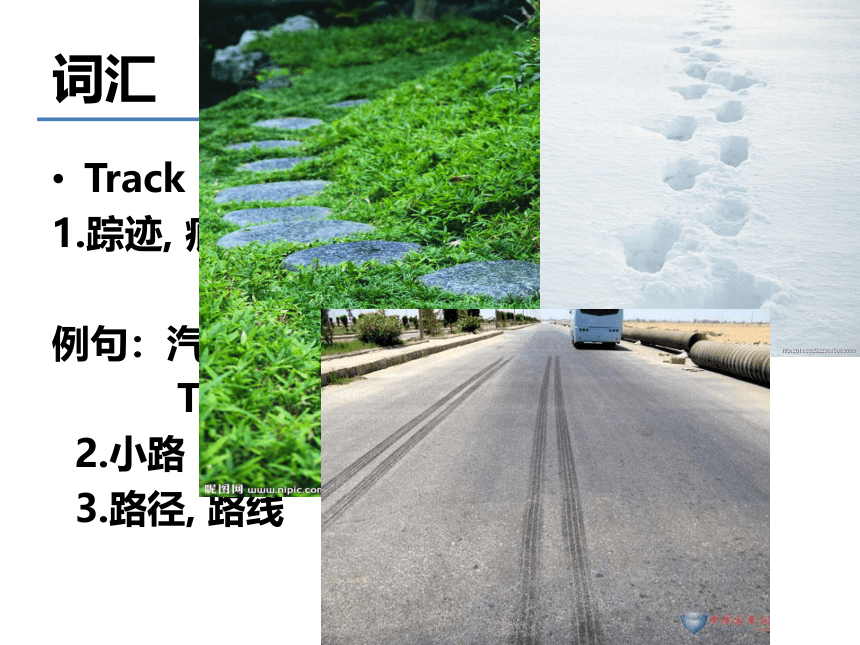
文档简介
(共78张PPT)
新概念一册
Lesson 129
70 miles an hour
Listening focus:
听力理解:
情态动词 表示推测
1. 情态动词+动词原形,表示对__________________推测。
例:He must be a teacher.
他一定是一名老师。(系表)
肯定的推断:
否定的推断:
可能的推断:
现在或将来的情况进行
must be 肯定是
can’t be 不可能是 (而不是mustn’t be)
may/can be 可能是
2. 情态动词+be doing,表示对
_______________推测。
例:He must be shopping now.
他一定正在逛街。
他们不可能正在睡觉吧。
They can’t be sleeping.
Jim may be playing the basketball.
吉姆可能正在打篮球。
正在进行的情况进行
Translation:
It must be cold outside.
外面肯定很冷。
They must be thirsty.
他们肯定很渴。
He can’t be Mr. Read.
他不可能是里德先生。
She can’t be late.
她不可能迟到。
New words and expressions
Wave [weiv]
n. 波, 波浪, 波涛;
vi. 挥手,招手
adj. 卷曲的,波状的 wavy
wavy hair
词汇
让我招手叫车开过来。 下次跟我挥手示意时,请至少伸出两根手指!
词汇
wave to
wave at
向某人挥手(有事) 和某人挥手(没事)
例句: 1.Let me wave to him to come .
2.Next time you wave at me, use more than one finger , please!
Track n.
1.踪迹, 痕迹, 足迹
例句:汽车的痕迹很明显。
The car tracks are very clear.
2.小路
3.路径, 路线
词汇
4.跑道
例句:这是一条跑道。
This is a running track.
词汇
mile n.英里 1英里=1.6km
米 meter
厘米 cm(centimeter)
英尺 feet
英寸 inch
公里 kilometer
码 yard
词汇
overtake v.
超车,超过,突然来临,突然出现(负面)
例句:
没有人能超过他。
No one can overtake him.
暴风雨突然袭击了小船。
A storm overtook the little boat.
词汇
Speed limit 限速
Speed n.速度,速率
兴奋剂
Limit n. / v. 限制
词汇
Dream n. 梦 v.做梦
常用搭配: have a dream
形容美梦:have a good/sweet dream
Good/Sweat dreams!
祝你做个好梦! 《口语》= Good night.
词汇
daydream : 思想开小差,白日梦
用法: dream of n/ving: 梦想做某事
例句:我梦想能飞上天。
I dreamed of flying in the sky.
dream aboat : 梦见…
词汇
Sign n.标记,记号
标牌,标志
v. 签字,做手势
Signature n. 签名
signal 信号
the traffic signal lights
词汇
Driving licence n.驾照
(在西方国家,等同于身份证)
Drive: v. 开车,驾车
Driver n.司机,高尔夫球杆
Licence n. 执照,牌照
词汇
Charge v. 罚钱
I will charge you.
n. 充电器 charger
in charge of …… 掌管…,负责…
你负责睡觉.
You're in charge of sleeping.
词汇
Notes on the text
What did the policeman talk to Gary
课文讲解
Look, Gary! That policeman’s waving to you. He wants you to stop.
Look! 瞧!(用来引起别人的注意)
瞧,你又哭了。
Look, you are crying again.
瞧,我不过是想帮个忙。
Look, I was only trying to help.
wave to you 向你招手
Where do you think you are On a race track
do you think 是特殊疑问句中的插入语,它用于征询见解或表达看法。
你认为你现在应做什么?
What do you think you can do now
你认为他是谁?
Who do you think he is
你猜我今天花了多少钱?
How much do you guess I spent today
on a race track
= Do you think you are on a race track
You must have been driving at seventy miles an hour.
must 一定是(表推测测)
其基句型结构有:
1)must + 动词原形:对现在或将来事情的推测
你一定是病了。
You must be sick.
2)must +be+ v-ing :对现在正在进行事情的推测
他们一定在喝酒。
They must be drinking now.
3)must +have +过去分词 对过去事情的推测
昨晚你一定喝酒了。
You must have drunk last night.
4)must + have been+ v-ing
表示对过去正在进行事情的推测。
昨天晚上我给你打电话的时候你肯定在喝酒
You must have been drinking when I called you last night.
前两周你肯定在为会议做准备工作。
You must have been preparing for the meeting in the last two weeks.
表示速度用at.
以每秒1000英里的速度
at 1000 miles a second
I can’t have been.
= I can’t have been driving at seventy miles an hour.
can’t (must表猜测时的否定形式)不可能
他不可能在伦敦,我今儿早还在这见到他的。
He can’t be in London. I saw him here only this morning.
你不可能在家,我都能听见火车的声音。
You can’t be at home. I can hear the noise of the train.
他们不可能昨天把活儿干完。
They can’t have finished their job yesterday.
你不可能是一直一个人呆着
You can’t have been staying alone.
I was doing eighty when I overtook you.
I was doing eighty.
=I was driving at eighty miles an hour.
overtake 超过
Didn’t you see the speed limit
I’m afraid I didn’t, officer.
I didn’t =I didn’t see the speed limit.
I must have been dreaming.
dream n. 梦; v. 做梦
这里引申为“思 想 开小差。”
He wasn’t dreaming, officer. I was telling him to drive slowly.
was telling 用进行时态加强语气证明“我一直都在告诉他”。
tell sb to do sth 告诉(叫)某人做…
叫他停下来。
Tell him to stop.
叫他走近点。
Tell him to come closer.
That’s why I didn’t see the sign.
That’s why….”所以“(用于解释原因)
这就是我迟到的原因
That’s why I was late.
这就是我生气的原因。
That’s why I am angry.
Let me see your driving licence.
Let sb do sth 让某人做某事
让我告诉你原因吧!
Let me tell you the reason.
I won’t charge you this time. But you’d better not do it again!
charge 罚款
you’d better =you had better
had better do sth 最好做某事(表建议)
had better not do sth 最好不做某事
你最好早点回来。
You’d better come back early.
你最好别告诉他实情。
You’d better not tell him the truth.
Thank you. I'll certainly be more careful.
I told you to drive slowly, Gary.
Tell sb to do sth 告诉某人做某事
You always tell me to drive slowly, darling.
Well, next time you’d better take my advice!
take one’s advice 接受某人的意见,听从某人的劝告,听某人的话。
我总告诉你要注意,但你从来不听我的话。
I always tell you to be careful, but you never take my advice.
超速处罚制度
在西方国家,交通法规十分严格。其中比较重要的就是,系安全带和超速,通常罚款220美元左右。但是超速一般按照超速多少算罚款,在澳大利亚,每超过5迈就会翻倍。
语言点
Grammar in use
—情态动词表示推测
Grammar
情态动词表推测:
对过去的推测及过去正在发生的推测
1. 对过去的推测
(1)肯定推测:must + have done “那时一定是”
Eg:我认为他那时一定很累。
I think he must have been tired.
我认为你一定吃过饭了。
I think you must have had dinner。
(2)否定推测:can’t have done “那时不可能是”
Eg:我认为他那时不可能累。
I think he can’t have been tired.
我认为他们那是不可能很忙。
I think they can’t have been busy。
(3)可能性推测:may/can have done “那时可能是”
Eg:我认为他那时可能累。
I think he can have been tired.
我认为他们那是可能很忙。
I think they can have been busy。
Grammar
2. 过去正在发生的推测
1)肯定推测:must have been doing “那时一定正在做…”
Eg:我认为他那时一定正在睡觉。
I think he must have been sleeping.
我认为他们那是一定正在读书。
I think they must have been reading。
(2)否定推测:can’t have been doing “那时不可能正在”
Eg:我认为他那时不可能正在睡觉。
I think he can’t have been sleeping.
我认为他们那是不可能正在读书。
I think they can’t have been reading。
(2)可能性推测:can/may have been doing“那时可能正在做..”
Eg:我认为他那时可能正在睡觉。
I think he can have been sleeping.
我认为他们那时可能正在读书。
I think they can have been reading 。
巧记must, can, may 表示“推测”的用法:
请看下面的顺口溜:
can不肯,may不问,
must肯定不否问。
这个顺口溜介绍了can (could), may (might), must 表“推测”时所适用的句式的区别。
从A、B、C、D四个选项中,选出最佳选项。
— Someone is knocking at the door.
— Who ______ it be at this hour of day
A. may B. can
C. must D. should
英语中,表示对过去某种情况进行推测或对已发生的动作或存在的状态进行推测,常用情态动词must, may, might, can, could, should, ought to, would等 + have + 过去分词表示。一般来说,说话人的语气或推测的把握程度不同,使用的情态动词也不同。
1)表过去的“可能”和“允许”多用于间接引语。
She said that he might take her dictionary.
2)表现在的“可能”,其可能性要比may小。
Electric irons could be dangerous; they might give you a severe shock.
电熨斗会有危险,它可能电着人。
3)may (might) + have +done 表示对过去发生行为的推测,含有“想必”、“也许是”的意思。
It may have been true.
1)表示请求、可以、允许。
You may drive the tractor.
2)当回答由may 引起的问题时,否定答语要用must not,表示“不许可”、“不应该”、“不行”。
May I come in
No, you mustn’t.
3) may /might 推测性用法 可能
He may be right.
might 和may用法注意:
1 只用于肯定和否定句中,不用于疑问句中。
2 might 比may可能性更小
may no 可能不 can not不可能
3)表建议(可和as well 连用)
You may(might)as well stay where you are.
还是……的好
4)表祝愿
can’t have been doing
must have been
must have been asleep
can’t be
can’t have driven
must be
1. 造句:用must和can’t各造三个表示对过去事情推测的句子.
2. 完成课练L129&L130.
3. 准备(听写) and (背诵) of L129
4. 预习 131
Homework
新概念一册
Lesson 129
70 miles an hour
Listening focus:
听力理解:
情态动词 表示推测
1. 情态动词+动词原形,表示对__________________推测。
例:He must be a teacher.
他一定是一名老师。(系表)
肯定的推断:
否定的推断:
可能的推断:
现在或将来的情况进行
must be 肯定是
can’t be 不可能是 (而不是mustn’t be)
may/can be 可能是
2. 情态动词+be doing,表示对
_______________推测。
例:He must be shopping now.
他一定正在逛街。
他们不可能正在睡觉吧。
They can’t be sleeping.
Jim may be playing the basketball.
吉姆可能正在打篮球。
正在进行的情况进行
Translation:
It must be cold outside.
外面肯定很冷。
They must be thirsty.
他们肯定很渴。
He can’t be Mr. Read.
他不可能是里德先生。
She can’t be late.
她不可能迟到。
New words and expressions
Wave [weiv]
n. 波, 波浪, 波涛;
vi. 挥手,招手
adj. 卷曲的,波状的 wavy
wavy hair
词汇
让我招手叫车开过来。 下次跟我挥手示意时,请至少伸出两根手指!
词汇
wave to
wave at
向某人挥手(有事) 和某人挥手(没事)
例句: 1.Let me wave to him to come .
2.Next time you wave at me, use more than one finger , please!
Track n.
1.踪迹, 痕迹, 足迹
例句:汽车的痕迹很明显。
The car tracks are very clear.
2.小路
3.路径, 路线
词汇
4.跑道
例句:这是一条跑道。
This is a running track.
词汇
mile n.英里 1英里=1.6km
米 meter
厘米 cm(centimeter)
英尺 feet
英寸 inch
公里 kilometer
码 yard
词汇
overtake v.
超车,超过,突然来临,突然出现(负面)
例句:
没有人能超过他。
No one can overtake him.
暴风雨突然袭击了小船。
A storm overtook the little boat.
词汇
Speed limit 限速
Speed n.速度,速率
兴奋剂
Limit n. / v. 限制
词汇
Dream n. 梦 v.做梦
常用搭配: have a dream
形容美梦:have a good/sweet dream
Good/Sweat dreams!
祝你做个好梦! 《口语》= Good night.
词汇
daydream : 思想开小差,白日梦
用法: dream of n/ving: 梦想做某事
例句:我梦想能飞上天。
I dreamed of flying in the sky.
dream aboat : 梦见…
词汇
Sign n.标记,记号
标牌,标志
v. 签字,做手势
Signature n. 签名
signal 信号
the traffic signal lights
词汇
Driving licence n.驾照
(在西方国家,等同于身份证)
Drive: v. 开车,驾车
Driver n.司机,高尔夫球杆
Licence n. 执照,牌照
词汇
Charge v. 罚钱
I will charge you.
n. 充电器 charger
in charge of …… 掌管…,负责…
你负责睡觉.
You're in charge of sleeping.
词汇
Notes on the text
What did the policeman talk to Gary
课文讲解
Look, Gary! That policeman’s waving to you. He wants you to stop.
Look! 瞧!(用来引起别人的注意)
瞧,你又哭了。
Look, you are crying again.
瞧,我不过是想帮个忙。
Look, I was only trying to help.
wave to you 向你招手
Where do you think you are On a race track
do you think 是特殊疑问句中的插入语,它用于征询见解或表达看法。
你认为你现在应做什么?
What do you think you can do now
你认为他是谁?
Who do you think he is
你猜我今天花了多少钱?
How much do you guess I spent today
on a race track
= Do you think you are on a race track
You must have been driving at seventy miles an hour.
must 一定是(表推测测)
其基句型结构有:
1)must + 动词原形:对现在或将来事情的推测
你一定是病了。
You must be sick.
2)must +be+ v-ing :对现在正在进行事情的推测
他们一定在喝酒。
They must be drinking now.
3)must +have +过去分词 对过去事情的推测
昨晚你一定喝酒了。
You must have drunk last night.
4)must + have been+ v-ing
表示对过去正在进行事情的推测。
昨天晚上我给你打电话的时候你肯定在喝酒
You must have been drinking when I called you last night.
前两周你肯定在为会议做准备工作。
You must have been preparing for the meeting in the last two weeks.
表示速度用at.
以每秒1000英里的速度
at 1000 miles a second
I can’t have been.
= I can’t have been driving at seventy miles an hour.
can’t (must表猜测时的否定形式)不可能
他不可能在伦敦,我今儿早还在这见到他的。
He can’t be in London. I saw him here only this morning.
你不可能在家,我都能听见火车的声音。
You can’t be at home. I can hear the noise of the train.
他们不可能昨天把活儿干完。
They can’t have finished their job yesterday.
你不可能是一直一个人呆着
You can’t have been staying alone.
I was doing eighty when I overtook you.
I was doing eighty.
=I was driving at eighty miles an hour.
overtake 超过
Didn’t you see the speed limit
I’m afraid I didn’t, officer.
I didn’t =I didn’t see the speed limit.
I must have been dreaming.
dream n. 梦; v. 做梦
这里引申为“思 想 开小差。”
He wasn’t dreaming, officer. I was telling him to drive slowly.
was telling 用进行时态加强语气证明“我一直都在告诉他”。
tell sb to do sth 告诉(叫)某人做…
叫他停下来。
Tell him to stop.
叫他走近点。
Tell him to come closer.
That’s why I didn’t see the sign.
That’s why….”所以“(用于解释原因)
这就是我迟到的原因
That’s why I was late.
这就是我生气的原因。
That’s why I am angry.
Let me see your driving licence.
Let sb do sth 让某人做某事
让我告诉你原因吧!
Let me tell you the reason.
I won’t charge you this time. But you’d better not do it again!
charge 罚款
you’d better =you had better
had better do sth 最好做某事(表建议)
had better not do sth 最好不做某事
你最好早点回来。
You’d better come back early.
你最好别告诉他实情。
You’d better not tell him the truth.
Thank you. I'll certainly be more careful.
I told you to drive slowly, Gary.
Tell sb to do sth 告诉某人做某事
You always tell me to drive slowly, darling.
Well, next time you’d better take my advice!
take one’s advice 接受某人的意见,听从某人的劝告,听某人的话。
我总告诉你要注意,但你从来不听我的话。
I always tell you to be careful, but you never take my advice.
超速处罚制度
在西方国家,交通法规十分严格。其中比较重要的就是,系安全带和超速,通常罚款220美元左右。但是超速一般按照超速多少算罚款,在澳大利亚,每超过5迈就会翻倍。
语言点
Grammar in use
—情态动词表示推测
Grammar
情态动词表推测:
对过去的推测及过去正在发生的推测
1. 对过去的推测
(1)肯定推测:must + have done “那时一定是”
Eg:我认为他那时一定很累。
I think he must have been tired.
我认为你一定吃过饭了。
I think you must have had dinner。
(2)否定推测:can’t have done “那时不可能是”
Eg:我认为他那时不可能累。
I think he can’t have been tired.
我认为他们那是不可能很忙。
I think they can’t have been busy。
(3)可能性推测:may/can have done “那时可能是”
Eg:我认为他那时可能累。
I think he can have been tired.
我认为他们那是可能很忙。
I think they can have been busy。
Grammar
2. 过去正在发生的推测
1)肯定推测:must have been doing “那时一定正在做…”
Eg:我认为他那时一定正在睡觉。
I think he must have been sleeping.
我认为他们那是一定正在读书。
I think they must have been reading。
(2)否定推测:can’t have been doing “那时不可能正在”
Eg:我认为他那时不可能正在睡觉。
I think he can’t have been sleeping.
我认为他们那是不可能正在读书。
I think they can’t have been reading。
(2)可能性推测:can/may have been doing“那时可能正在做..”
Eg:我认为他那时可能正在睡觉。
I think he can have been sleeping.
我认为他们那时可能正在读书。
I think they can have been reading 。
巧记must, can, may 表示“推测”的用法:
请看下面的顺口溜:
can不肯,may不问,
must肯定不否问。
这个顺口溜介绍了can (could), may (might), must 表“推测”时所适用的句式的区别。
从A、B、C、D四个选项中,选出最佳选项。
— Someone is knocking at the door.
— Who ______ it be at this hour of day
A. may B. can
C. must D. should
英语中,表示对过去某种情况进行推测或对已发生的动作或存在的状态进行推测,常用情态动词must, may, might, can, could, should, ought to, would等 + have + 过去分词表示。一般来说,说话人的语气或推测的把握程度不同,使用的情态动词也不同。
1)表过去的“可能”和“允许”多用于间接引语。
She said that he might take her dictionary.
2)表现在的“可能”,其可能性要比may小。
Electric irons could be dangerous; they might give you a severe shock.
电熨斗会有危险,它可能电着人。
3)may (might) + have +done 表示对过去发生行为的推测,含有“想必”、“也许是”的意思。
It may have been true.
1)表示请求、可以、允许。
You may drive the tractor.
2)当回答由may 引起的问题时,否定答语要用must not,表示“不许可”、“不应该”、“不行”。
May I come in
No, you mustn’t.
3) may /might 推测性用法 可能
He may be right.
might 和may用法注意:
1 只用于肯定和否定句中,不用于疑问句中。
2 might 比may可能性更小
may no 可能不 can not不可能
3)表建议(可和as well 连用)
You may(might)as well stay where you are.
还是……的好
4)表祝愿
can’t have been doing
must have been
must have been asleep
can’t be
can’t have driven
must be
1. 造句:用must和can’t各造三个表示对过去事情推测的句子.
2. 完成课练L129&L130.
3. 准备(听写) and (背诵) of L129
4. 预习 131
Homework
同课章节目录
